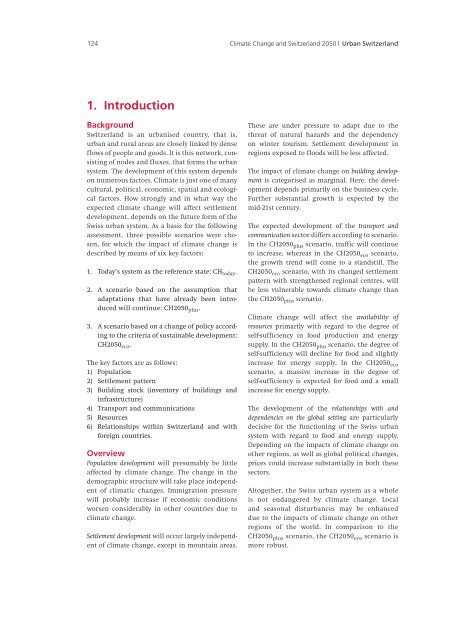Climate Change and Switzerland 2050 - OcCC - SCNAT
Climate Change and Switzerland 2050 - OcCC - SCNAT
Climate Change and Switzerland 2050 - OcCC - SCNAT
You also want an ePaper? Increase the reach of your titles
YUMPU automatically turns print PDFs into web optimized ePapers that Google loves.
124 <strong>Climate</strong> <strong>Change</strong> <strong>and</strong> Switzerl<strong>and</strong> <strong>2050</strong> | Urban Switzerl<strong>and</strong><br />
1. Introduction<br />
Background<br />
Switzerl<strong>and</strong> is an urbanised country, that is,<br />
urban <strong>and</strong> rural areas are closely linked by dense<br />
flows of people <strong>and</strong> goods. It is this network, consisting<br />
of nodes <strong>and</strong> fluxes, that forms the urban<br />
system. The development of this system depends<br />
on numerous factors. <strong>Climate</strong> is just one of many<br />
cultural, political, economic, spatial <strong>and</strong> ecological<br />
factors. How strongly <strong>and</strong> in what way the<br />
expected climate change will affect settlement<br />
development, depends on the future form of the<br />
Swiss urban system. As a basis for the following<br />
assessment, three possible scenarios were chosen,<br />
for which the impact of climate change is<br />
described by means of six key factors:<br />
1. Today’s system as the reference state: CHtoday.<br />
2. A scenario based on the assumption that<br />
adaptations that have already been introduced<br />
will continue: CH<strong>2050</strong>plus. 3. A scenario based on a change of policy according<br />
to the criteria of sustainable development:<br />
CH<strong>2050</strong>eco. The key factors are as follows:<br />
1) Population<br />
2) Settlement pattern<br />
3) Building stock (inventory of buildings <strong>and</strong><br />
infrastructure)<br />
4) Transport <strong>and</strong> communications<br />
5) Resources<br />
6) Relationships within Switzerl<strong>and</strong> <strong>and</strong> with<br />
foreign countries.<br />
Overview<br />
Population development will presumably be little<br />
affected by climate change. The change in the<br />
demographic structure will take place independent<br />
of climatic changes. Immigration pressure<br />
will probably increase if economic conditions<br />
worsen considerably in other countries due to<br />
climate change.<br />
Settlement development will occur largely independent<br />
of climate change, except in mountain areas.<br />
These are under pressure to adapt due to the<br />
threat of natural hazards <strong>and</strong> the dependency<br />
on winter tourism. Settlement development in<br />
regions exposed to floods will be less affected.<br />
The impact of climate change on building development<br />
is categorised as marginal. Here, the development<br />
depends primarily on the business cycle.<br />
Further substantial growth is expected by the<br />
mid-21st century.<br />
The expected development of the transport <strong>and</strong><br />
communication sector differs according to scenario.<br />
In the CH<strong>2050</strong> plus scenario, traffic will continue<br />
to increase, whereas in the CH<strong>2050</strong> eco scenario,<br />
the growth trend will come to a st<strong>and</strong>still. The<br />
CH<strong>2050</strong> eco scenario, with its changed settlement<br />
pattern with strengthened regional centres, will<br />
be less vulnerable towards climate change than<br />
the CH<strong>2050</strong> plus scenario.<br />
<strong>Climate</strong> change will affect the availability of<br />
resources primarily with regard to the degree of<br />
self-sufficiency in food production <strong>and</strong> energy<br />
supply. In the CH<strong>2050</strong> plus scenario, the degree of<br />
self-sufficiency will decline for food <strong>and</strong> slightly<br />
increase for energy supply. In the CH<strong>2050</strong> eco<br />
scenario, a massive increase in the degree of<br />
self-sufficiency is expected for food <strong>and</strong> a small<br />
increase for energy supply.<br />
The development of the relationships with <strong>and</strong><br />
dependencies on the global setting are particularly<br />
decisive for the functioning of the Swiss urban<br />
system with regard to food <strong>and</strong> energy supply.<br />
Depending on the impacts of climate change on<br />
other regions, as well as global political changes,<br />
prices could increase substantially in both these<br />
sectors.<br />
Altogether, the Swiss urban system as a whole<br />
is not endangered by climate change. Local<br />
<strong>and</strong> seasonal disturbances may be enhanced<br />
due to the impacts of climate change on other<br />
regions of the world. In comparison to the<br />
CH<strong>2050</strong> plus scenario, the CH<strong>2050</strong> eco scenario is<br />
more robust.

















